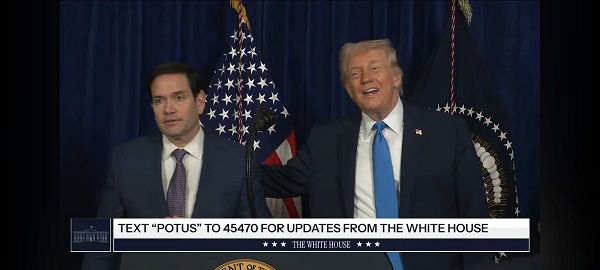Opinion
Premier Scientific Journal Nature Takes on ‘Climate of Fear’ Surrounding Research on Sex and Genr

From Heartland Daily News
“These articles are using phrases like ‘a person’s sex assigned at birth’. I find that phrase amusing. I don’t think sex is assigned at birth. Biological sex is a fact. It’s not assigned. It’s observed.”
Nature, one of the world’s premier scientific journals, has acknowledged the importance of studying sex and gender differences and officially denounced the “climate of fear and reticence” that is stymying research on the topic.
To that end, the journal in May launched “a collection of opinion articles” on the topic to be published over the coming months to foster honest and courageous discussions on a topic that many scientists shy away from due to fears of professional and personal repercussions.
“Some scientists have been warned off studying sex differences by colleagues. Others, who are already working on sex or gender-related topics, are hesitant to publish their views,” read the editorial introducing the series.
“…In time, we hope this collection will help to shape research, and provide a reference point for moderating often-intemperate debates.”
Headlines that kicked off the series include “Neglecting sex and gender in research is a public-health risk,” “Male–female comparisons are powerful in biomedical research” and “Heed lessons from past studies involving transgender people: first, do no harm.”
What the collection of articles represents and whether it will ease tensions surrounding this area of research remains to be seen.
Jeffrey Mogil, a neuroscientist and pain researcher at Mcgill University, as well as the co-author of one of the articles in Nature’s sex and gender series, told The College Fix there is an effort underway in biological research to do away with or minimize the importance of the concept of sex and sex as a binary variable.
This is problematic, Mogil said in a recent telephone interview, because sex in mammals is “either binary or it rounds to binary and in doing so it always has been useful and continues to be and any conception of it that isn’t binary would then impose practical difficulties on how science is done.”
Moreover, he noted, discarding the notion of binary sex in mammals would set back important advancements in how many biomedical researchers now do their work.
“There are sex differences in all kinds of traits that we’re interested in and where we didn’t know they existed,” Mogil said. “The reason we didn’t know they existed [is] because until extremely recently, essentially all biology pre-clinical experiments were done with males only.”
“Since regulatory agencies, funding agencies, have demanded that people start using both sexes [in research],” he said, “lo and behold, we’re finding sex differences.”
“We’re finding that what we thought was the biology of a thing was only the biology of the thing in males and the female biology is completely different,” he added.
“This is in our minds,” he said, “an incredible scientific advance and that advance is at risk of stopping and reverting if, you know, people start to believe…dividing animals into males and females is inappropriate.”
Although Mogil stated he did not know how Nature made editorial decisions regarding the selection of articles for their sex and gender collection, he said that he felt the article he and his co-authors wrote was intended to defend the status quo against those “advocating…either that gender is much more important than sex or that sex is more complicated than people have made it seem.”
The College Fix reached out to a senior communications manager from Springer Nature in early June regarding the selection process for the series, as well as how sex was presented in some of the other commentaries, but did not receive a response.
Daniel Barbash, a professor of molecular biology and genetics at Cornell University, was more skeptical than Mogil of Nature’s sex and gender op-ed collection when he spoke to The College Fix in a late-May phone interview.
Although he said he generally held a positive view of the article Mogil co-authored and appreciated that it explicitly stated “there are only two sex categories in mammals,” he noted that he also felt the authors of other commentaries in the series were to some extent “further conflating sex and gender.”
“There’s little things that sometimes give the game away,” he said. “These articles are using phrases like ‘a person’s sex assigned at birth’. I find that phrase amusing. I don’t think sex is assigned at birth. Biological sex is a fact. It’s not assigned. It’s observed.”
“[For] the vast majority of humans, from the moment they’re born,” he said, “there is zero ambiguity whether they’re a male or a female.”
Furthermore, the “overall tone” of the collection, Barbash said, was that “there needs to be more research on gender variation and that there is more complexity to biological sex than a binary.”
According to Barbash, neither of these notions are “universally accepted” among biologists.
He said he believes the series has “the potential to drive funding agencies and other agencies that are involved in the intersection between politics and research in a particular direction that I don’t think would always be helpful.”
“I don’t think any serious biologist would deny that sex is a hugely important factor in both basic research and in biomedical research,” said Barbash. “Of course, any study on the effect of drugs should be tested separately in males and females, otherwise it’s a hugely confounding factor if you ignore that.”
Yet, he said, “the notion that we need to do the same thing for gender…is really not supported,” and may not be very feasible.
“Half the population is male and half the population is female,” Barbash said. “We see all kinds of estimates for gender nonconforming and transgender individuals but, no doubt, they’re much less frequent than males and females.”
On account of this, he said, even if research questions regarding gender divergence and transgender individuals are worthwhile, “it would be problematic, for example, to necessitate that all NIH studies of humans include males, females and gender nonconforming individuals or transgender individuals.”
However, he said, he feared “this series of articles could have that kind of impact in influencing policy.”
Originally published by The College Fix. Republished with permission.
Business
Chrystia Freeland Didn’t Leave Power. She Just Took It Somewhere Else

Canadians were told freezing bank accounts was “necessary.” We were told sending billions overseas without a vote was “solidarity.” And now we’re told that Chrystia Freeland the architect of some of the most aggressive financial overreach in modern Canadian history advising a foreign government on economic policy is “normal.” It isn’t. It’s a closed circle of power rewarding itself, while ordinary Canadians are expected to forget what was done to them and quietly foot the bill.
I don’t believe in coincidences in politics and I don’t believe in “honourary” appointments when billions of dollars and unchecked power are involved. So when Chrystia Freeland, the same woman who helped freeze Canadians’ bank accounts, torched public trust, and oversaw economic decisions that hollowed out this country is suddenly appointed as an economic adviser to Ukraine, Canadians should stop and ask a very uncomfortable question.
Kelsi Sheren is a reader-supported publication.
To receive new posts and support my work, consider becoming a free or paid subscriber.
Who exactly is Chrystia serving? Because it doesn’t look like us and doesn’t feel like us at all. I’m going to make something very clear and spell it out for Canadians… this is the same elite just moved to a different country.
Chrystia Freeland did not leave politics because she failed. She didn’t resign because she was rejected. She exited after years of consolidating power at the highest levels of government and immediately landed an advisory role with a foreign head of state.
That is not a fall from grace. That is a lateral move inside the same elite ecosystem.
Multiple Canadian outlets have now confirmed that Freeland has been named an economic adviser to Ukrainian President Zelenskyy. This is not symbolic. This is not charity. This is about economic reconstruction, international financing, sanctions, and the movement of billions of dollars, much of it, if not all of it is Western taxpayer money.
Including ours.
Has everyone forgotten what this women did to Canadians?? Before anyone starts calling this “statesmanship,” let’s remember the record.
Chrystia Freeland was a central figure during one of the most dangerous moments in modern Canadian governance: the normalization of financial punishment against citizens.
Under her watch, the federal government froze bank accounts without criminal charges, without due process, and without judicial oversight. Whatever your view of the Freedom Convoy, that precedent should have terrified you and if it doesn’t you need to wake up.
Once a government proves it can financially erase you for dissent, it never unlearns that lesson.
She also presided over years of reckless spending, inflationary pressure, and policies that pushed Canadians into a cost-of-living crisis while telling them everything was fine. Housing exploded. Food prices surged. Small businesses collapsed.
And now — suddenly — she’s being handed influence over another country’s economic future? The money no one voted on is now gone with no recourse and she knows it.
Canada has already sent billions of dollars to Ukraine, including roughly $2.5 billion tied to frozen Russian assets — without any direct vote from Canadians and with minimal parliamentary scrutiny.
Let that sit for a minute.
Our government helped set a precedent where foreign sovereign assets are frozen, leveraged, and redirected — and now one of the architects of that approach is advising the very government receiving the funds.
You don’t need to be a lawyer to understand how rotten that looks. At minimum, this is a conflict of interest. At worst, it’s a closed-loop system where the same political actors make the rules, move the money, and then step into advisory roles on the receiving end.
That’s not democracy. That’s managed power. People will say, “Ukraine needs help rebuilding.” Fine. That’s not the argument. The argument is who decides, who benefits, and who is accountable.
Chrystia Freeland still carries enormous influence inside Canada’s political and financial institutions. Her appointment creates a pipeline — informal, opaque, and unaccountable between Canadian decision-makers and a foreign government dependent on Western funds.
If an average Canadian MP took a paid or unpaid advisory role with a foreign government, alarms would be ringing, but when it’s Chrystia Freeland, we’re told it’s noble. Necessary. Above criticism.
That’s how corruption survives. Not through secrecy, but through normalization.
Canadians are always last, here’s the pattern Canadians are starting to see clearly, I hope. Canadians are being forced to tighten their belts. Canadians lose purchasing power on almost everything and Canadians are told to accept less and the sad part is Canadians are good with this.
Meanwhile, political elites move effortlessly between governments, NGOs, global institutions, and advisory boards. All it is, is different flags. Same class of people.
The people who suffered under Freeland’s economic policies don’t get to resign into prestige. They get debt. They get anxiety. They get silence.
She gets influence.
In case your wondering, this isn’t really about Ukraine, this is not an attack on Ukraine or its people. This is about Canadian democracy, accountability, and the dangerous precedent being set when unelected influence replaces public consent.
If Canadians are expected to fund wars, reconstruction, and foreign policy projects — then Canadians deserve transparency, debate, and representation.
Instead, we’re getting appointments behind closed doors and press releases that assume we won’t ask questions.
That era is long over.
Chrystia Freeland didn’t disappear. She didn’t retreat. She repositioned.
If Canadians don’t start calling this what it is — elite continuity without consent — then we shouldn’t be surprised when the same tactics used against citizens at home are exported abroad.
Power always practices somewhere first.
KELSI SHEREN
– – – – – – – – – – – –
One Time Donation! – Paypal – https://paypal.me/
Buy me a coffee! – https://buymeacoffee.com/
Let’s connect!
Youtube – https://www.youtube.com/@
Instagram: https://www.instagram.com/
Substack: https://substack.com/@
TikTok – https://x.com/KelsiBurns
Courageous Discourse
Largest rollback of routine childhood vaccination in U.S. history

CDC SHRINKS ROUTINE CHILDHOOD VACCINE SCHEDULE BY ~55 DOSES
Today, the CDC formally adopted a revised childhood and adolescent immunization schedule, following a Presidential Memorandum directing alignment with international best practices.
This marks the largest rollback of routine childhood vaccination in U.S. history.
After reviewing peer-country schedules and the scientific evidence underlying them, federal health leadership acknowledged that we are hyper-vaccinating our children.
The result is a dramatically smaller routine childhood vaccine schedule, cutting approximately 55 routine doses.
This is a major victory — even as serious safety concerns remain for the vaccines that continue to be recommended.
The Key Change: ~55 Routine Doses Eliminated
Previous U.S. routine schedule (2024)
- 84–88 routine vaccine doses
- Targeting 17 diseases
- (18 if RSV monoclonal antibody is included)
New CDC routine schedule (2026)
- ~30 routine doses
- Targeting 10–11 diseases
- Based on international consensus
Net change: approximately 54–58 routine doses removed, commonly summarized as ~55 routine doses.
Importantly, this reduction applies only to vaccines previously labeled “routine for all children.” No vaccines were banned or removed from availability.
What Was Removed from the Routine Schedule
The following vaccines are no longer recommended for all children by default:
- COVID-19
- Influenza
- Hepatitis A
- Hepatitis B (including removal of the universal birth dose if the mother is HBsAg-negative)
- Rotavirus
- Meningococcal ACWY
- Meningococcal B
These vaccines account for nearly the entire ~55-dose reduction.
What Remains Routine
The CDC now limits routine childhood vaccination to the following vaccines:
- Measles, Mumps, Rubella (MMR)
- Diphtheria
- Tetanus
- Pertussis
- Polio
- Haemophilus influenzae type B (Hib)
- Pneumococcal disease
- Varicella (chickenpox)
- Human Papillomavirus (HPV), reduced from two doses to one
This is still not “safe by default”
These vaccines remain:
- Insufficiently studied for long-term outcomes
- Untested in placebo-controlled trials
- Never evaluated as a cumulative schedule
- Inducers of over 20 chronic diseases
Adverse events such as febrile seizures, severe neurological injury including autism, ADHD, tics, autoimmune disease, asthma, allergies, skin and gut disorders, ear infections, and a long list of other chronic diseases have been documented across multiple vaccines on this list:
|
Reducing the schedule does not equal proving safety. It simply reduces exposure. Nonetheless, that reduction alone is quite meaningful.
Where Those Vaccines Went
Non-consensus vaccines were reclassified, not banned:
Shared Clinical Decision-Making
- COVID-19
- Influenza
- Hepatitis A
- Hepatitis B
- Rotavirus
- Meningococcal ACWY
- Meningococcal B
High-Risk Groups Only
- RSV monoclonal antibody
- Hepatitis A (travel, outbreaks, liver disease)
- Hepatitis B (HBsAg-positive or unknown maternal status)
- Dengue
- Meningococcal vaccines for defined risk groups
All remain available and fully covered by insurance. However, given entrenched institutional habits and ideological adherence to maximal vaccination, many clinicians are likely to continue promoting shared clinical decision-making vaccines as de facto routine unless families are informed and assertive.
Why This Is Still a Massive Win
For decades, the childhood vaccine schedule expanded without:
- Schedule-level safety trials
- Long-term outcome data
- Meaningful public debate
- Informed consent
This decision reverses that trajectory. It:
- Shrinks routine exposure dramatically
- Restores parental agency
- Forces future decisions to confront risk-benefit reality
Most importantly, it breaks the false premise that “more vaccines is always better.”
Conclusion
The CDC has eliminated every non-consensus vaccine from the routine childhood schedule, cutting routine exposure by approximately 55 doses—an implicit admission that the safety of the expanded schedule was never adequately established.
This decision does not end the problem. The vaccines that remain routinely recommended are still largely untested in long-term, placebo-controlled trials, are administered during critical periods of neurodevelopment, and continue to pose serious safety concerns. As a result, a substantial number of autism cases and other chronic conditions will continue to occur.
However, by sharply reducing cumulative exposure during early childhood, this change marks the first credible step toward reversing the trajectory. The burden of neurodevelopmental injury should begin to decline—not disappear, but diminish.
Even with its limitations, this action represents the most consequential course correction in U.S. pediatric vaccination policy in modern history. It breaks the assumption that an ever-expanding schedule is inherently safe, restores proportionality, and opens the door to long-overdue accountability, transparency, and real safety science.
Epidemiologist and Foundation Administrator, McCullough Foundation
Support our mission: mcculloughfnd.org
Please consider following both the McCullough Foundation and my personal account on X (formerly Twitter) for further content.
FOCAL POINTS (Courageous Discourse) is a reader-supported publication.
To receive new posts and support my work, consider becoming a free or paid subscriber.
-

 Daily Caller2 days ago
Daily Caller2 days agoTrump Says US Going To Run Venezuela After Nabbing Maduro
-

 Daily Caller2 days ago
Daily Caller2 days agoScathing Indictment Claims Nicolás Maduro Orchestrated Drug-Fueled ‘Culture Of Corruption’ Which Plagued Entire Region
-

 Business2 days ago
Business2 days agoVirtue-signalling devotion to reconciliation will not end well
-

 Frontier Centre for Public Policy12 hours ago
Frontier Centre for Public Policy12 hours agoIs Canada still worth the sacrifice for immigrants?
-

 Opinion2 days ago
Opinion2 days agoHell freezes over, CTV’s fabrication of fake news and our 2026 forecast is still searching for sunshine
-

 International9 hours ago
International9 hours agoMaduro, wife plead not guilty in first court appearance
-

 Courageous Discourse8 hours ago
Courageous Discourse8 hours agoLargest rollback of routine childhood vaccination in U.S. history
-

 Business7 hours ago
Business7 hours agoChrystia Freeland Didn’t Leave Power. She Just Took It Somewhere Else














